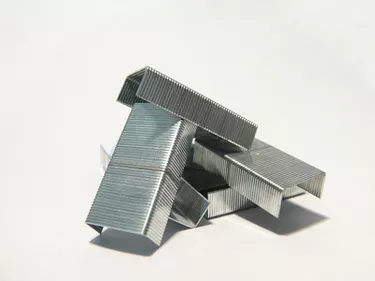
Metal fasteners can be used to join materials such as wood, sheet metal, plastic or even fabrics together. Made from steel, brass, aluminum or other metals, these fasteners come in a variety of shapes and sizes to suit the needs of different projects. Choosing the right metal fastener can allow you to maximize the performance of your next project while reducing maintenance and repair requirements over time.
Threaded Fasteners
Video of the Day
Threaded fasteners include a large variety of screws and bolts. These fasteners have teeth, or threads cut into the shank to help the fastener better grip wood or metal upon installation. Sheet metal screws feature threads along the entire length of the shank, while wood screws often feature threads along only half of the shank. The number of threads along the screw determine how course or fine the screw is rated, which helps users decide the best screw for each application.
Video of the Day
Bolts are a larger type of threaded metal fastener, and are used in conjunction with nuts to hold them in place. Metal studs resemble a screw or bolt, but have no head. Instead, the fastener is threaded along its entire length to join too pieces of material closely together.
All threaded fasteners represent a non-permanent method of joining objects.
Non-Threaded Fasteners
Non-threaded fasteners include many different kinds of nails, including common nails, finishing and brads. Installers use a hammer to drive these fasteners into wood and other materials.
Pins, keys and dowels also serve as popular non-threaded fasteners. These metal items fit into a groove or hole cut into one or more objects to hold them together or secure them in place.
Staples are yet another form of metal fastener. While small staples are used to join paper, more heavy-duty versions are used with wood, fabric and leather. Flat staples are used to fasten two objects, while rounded versions serve to join wire or tubing to a surface.
Rivets
Rivets represent a permanent form of metal fastener. Installers create a hole in an object just larger than the rivet, then install the rivet using a hammer or specialty tool. Some of these tools pull the ends of the rivet back through the fastener, forming a "blind" rivet. Rivets feature a smooth, non-threaded body, and serve as an alternate to welding in many sheet metal applications.
Corrugated Fasteners
Corrugated fasteners consist of strips of metal joined together in a wavy or zig-zag pattern. One side of the fastener features sharp points, while the other side is smooth. By hammering the pointed end into wood, workers can join two or more wooden beams. These fasteners are commonly used for rough framing when the appearance of the fastener is unimportant.
Other Metal Fasteners
Specialty fasteners can be used to join leather or fabrics. These include things like zippers, hook and eye fasteners and even metal snaps or buttons.